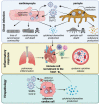Cardiovascular Tropism and Sequelae of SARS-CoV-2 Infection
- PMID: 35746609
- PMCID: PMC9228192
- DOI: 10.3390/v14061137
Cardiovascular Tropism and Sequelae of SARS-CoV-2 Infection
Abstract
The extrapulmonary manifestation of coronavirus disease-19 (COVID-19), caused by severe acute respiratory syndrome coronavirus 2 (SARS-CoV-2), became apparent early in the ongoing pandemic. It is now recognized that cells of the cardiovascular system are targets of SARS-CoV-2 infection and associated disease pathogenesis. While some details are emerging, much remains to be understood pertaining to the mechanistic basis by which SARS-CoV-2 contributes to acute and chronic manifestations of COVID-19. This knowledge has the potential to improve clinical management for the growing populations of patients impacted by COVID-19. Here, we review the epidemiology and pathophysiology of cardiovascular sequelae of COVID-19 and outline proposed disease mechanisms, including direct SARS-CoV-2 infection of major cardiovascular cell types and pathogenic effects of non-infectious viral particles and elicited inflammatory mediators. Finally, we identify the major outstanding questions in cardiovascular COVID-19 research.
Keywords: COVID-19; SARS-CoV-2; cardiomyocyte; myocarditis; pericyte; post-acute sequelae of SARS-CoV-2 infection; thrombosis.
Conflict of interest statement
The authors declare no conflict of interest.
Figures


Comment in
-
Cardiovascular disorders followed by SARS-CoV-2 infection: An inevitable challenge - Correspondence.Int J Surg. 2022 Aug;104:106830. doi: 10.1016/j.ijsu.2022.106830. Epub 2022 Aug 8. Int J Surg. 2022. PMID: 35953019 Free PMC article. No abstract available.
Similar articles
-
Cell-Specific Mechanisms in the Heart of COVID-19 Patients.Circ Res. 2023 May 12;132(10):1290-1301. doi: 10.1161/CIRCRESAHA.123.321876. Epub 2023 May 11. Circ Res. 2023. PMID: 37167361 Free PMC article. Review.
-
COVID-19: a conundrum to decipher.Eur Rev Med Pharmacol Sci. 2020 May;24(10):5830-5841. doi: 10.26355/eurrev_202005_21378. Eur Rev Med Pharmacol Sci. 2020. PMID: 32495923
-
Pathogenesis-directed therapy of 2019 novel coronavirus disease.J Med Virol. 2021 Mar;93(3):1320-1342. doi: 10.1002/jmv.26610. Epub 2020 Nov 10. J Med Virol. 2021. PMID: 33073355 Review.
-
Molecular consequences of SARS-CoV-2 liver tropism.Nat Metab. 2022 Mar;4(3):310-319. doi: 10.1038/s42255-022-00552-6. Epub 2022 Mar 28. Nat Metab. 2022. PMID: 35347318 Free PMC article.
-
Comparative tropism, replication kinetics, and cell damage profiling of SARS-CoV-2 and SARS-CoV with implications for clinical manifestations, transmissibility, and laboratory studies of COVID-19: an observational study.Lancet Microbe. 2020 May;1(1):e14-e23. doi: 10.1016/S2666-5247(20)30004-5. Epub 2020 Apr 21. Lancet Microbe. 2020. PMID: 32835326 Free PMC article.
Cited by
-
Subacute hemorrhagic pericardial tamponade after COVID-19 infection mimicking carcinomatous pericarditis: a case report.Front Cardiovasc Med. 2024 Jan 9;10:1329952. doi: 10.3389/fcvm.2023.1329952. eCollection 2023. Front Cardiovasc Med. 2024. PMID: 38264260 Free PMC article.
-
COVID-19: The Many Ways to Hurt Your Heart.Viruses. 2023 Feb 1;15(2):416. doi: 10.3390/v15020416. Viruses. 2023. PMID: 36851629 Free PMC article.
-
COVID-19-Induced Myocarditis: Pathophysiological Roles of ACE2 and Toll-like Receptors.Int J Mol Sci. 2023 Mar 11;24(6):5374. doi: 10.3390/ijms24065374. Int J Mol Sci. 2023. PMID: 36982447 Free PMC article. Review.
-
Cardiovascular disorders followed by SARS-CoV-2 infection: An inevitable challenge - Correspondence.Int J Surg. 2022 Aug;104:106830. doi: 10.1016/j.ijsu.2022.106830. Epub 2022 Aug 8. Int J Surg. 2022. PMID: 35953019 Free PMC article. No abstract available.
-
Myocarditis in Cats with Feline Infectious Peritonitis Can Be Cured with GS-441524 and Symptomatic Cardiovascular Treatment.Animals (Basel). 2025 Jun 4;15(11):1660. doi: 10.3390/ani15111660. Animals (Basel). 2025. PMID: 40509126 Free PMC article.
References
-
- The Johns Hopkins University School of Medicine COVID-19 Dashboard by the Center for Systems Science and Engineering (CSSE) at Johns Hopkins University (JHU) [(accessed on 2 April 2022)]. Available online: https://publichealthupdate.com/jhu/
Publication types
MeSH terms
Grants and funding
LinkOut - more resources
Full Text Sources
Medical
Miscellaneous

